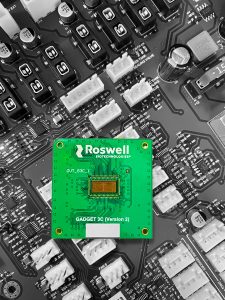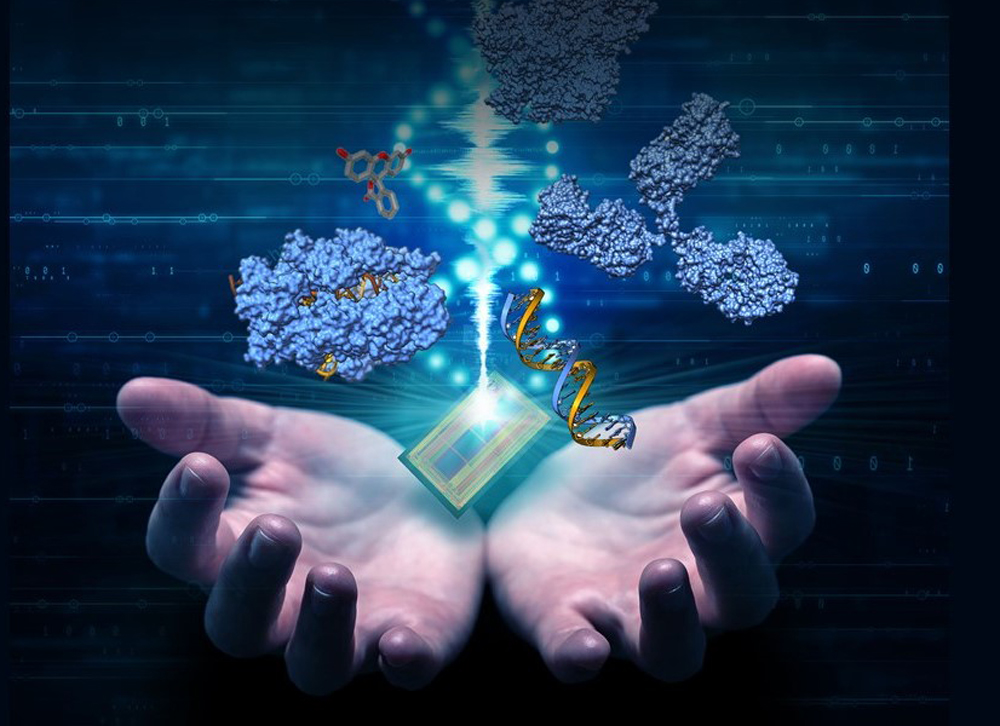The success of molecular medicine and biotechnology rests on the ability to measure molecular interactions in a variety of samples with speed, sensitivity, and accuracy.
In an article published in the Proceedings of the National Academy of Sciences (PNAS), titled, “Molecular electronics sensors on a scalable semiconductor chip: A platform for single-molecule measurement of binding kinetics and enzyme activity,” a multi-disciplinary team of scientists from the University of California, San Diego, Harvard Medical School, Rice University, and Roswell Biotechnologies has developed the first molecular electronics chip that integrates single molecular sensors into a programmable biosensor circuit that can detect molecular interactions in real-time with single-molecule sensitivity and scalability.

“The mobile phone transformed communications by leaps and bounds. This was powered by semiconductor chip technology. The Roswell molecular electronic chip provides the ideal digital biosensor platform and is poised to transform biology in a similar manner. Going on chip means we can lock accessibility for all with low-cost, smart, powerful, all-electronic devices,” said Paul Mola, PhD, founder, president, and CEO at Roswell Biotechnologies.
This innovation is poised to power discoveries in a variety of areas of biotechnology such as drug discovery, diagnostics, DNA sequencing, and proteomics, that are fueled by insights into the physical interaction of biomolecules.
“Biology works by single molecules talking to each other, but our existing measurement methods cannot detect this,” said Jim Tour, PhD, professor of chemistry at Rice University and co-author of the paper. “The sensors demonstrated in this paper for the first time let us listen in on these molecular communications, enabling a new and powerful view of biological information.”
The biosensor device is a semiconductor chip with a scalable array architecture where molecular circuit elements act as general-purpose single-molecule sensors. A synthetic molecular wire—a 25-nanometer long peptide—connects nanoelectrodes in each element of the circuit that monitors current.
“The chip we demonstrate in the paper has 16,000 independent sensors that will independently be monitoring the solution we expose it to,” said Barry Merriman, PhD, CSO at Roswell Biotechnologies.
The biosensor can be programmed through the attachment of a desired molecular probe to the molecular wire at a central conjugation site. This site defines the target of the sensor. The arrayed chip converts the current-by-time readout in picoampere scale from each element of the array into digital information at the rate of 1,000 frames per second. This provides direct real-time digital data on molecular interactions from the electrical signatures generated through probe and target interactions in test solutions, with high-resolution, -throughput and accuracy.

Importantly, this new platform can be used to measure parallel interaction kinetics of single molecules, without any labels encumbering the interacting molecules. Traditional approaches generally involve labeling interacting molecules, which can in turn influence the interactions.
“The goal of this work is to put biosensing on an ideal technology foundation for the future of precision medicine and personal wellness,” said Merriman.
“This requires not only putting biosensing on chip, but in the right way, with the right kind of sensor. We’ve pre-shrunk the sensor element to the molecular level to create a biosensor platform that combines an entirely new kind of real-time, single-molecule measurement with a long-term, unlimited scaling roadmap for smaller, faster and cheaper tests and instruments,” added Merriman.
The biosensor accommodates a variety of probe molecules including DNA, aptamers, antibodies, antigens, and enzymes relevant to diagnostics and sequencing, such as CRISPR Cas enzymes binding target DNA sequences. This versatility allows the electronic platform to measure multiomic molecular interactions at single-molecule resolution, in real-time. The biosensor can therefore be used for diverse applications such as developing COVID-19 tests and discovering new drugs.
“The Roswell sequencing sensor provides a new, direct view of polymerase activity, with the potential to advance sequencing technology by additional orders of magnitude in speed and cost,” said George Church, PhD, a co-author of the paper, member of the National Academy of Sciences, and a member of Roswell’s Scientific Advisory Board.
To demonstrate the applicability of the new platform, the authors used the biosensor to read DNA sequences. They used a sensor chip where a DNA polymerase, the enzyme that copies DNA, is integrated into the circuit, and the result is direct electrical observation of the action of this enzyme as it copies a piece of DNA, letter by letter. This approach achieves direct, real-time sequence readouts as the DNA polymerase enzyme incorporating nucleotides. These electrical signals can be analyzed with machine learning algorithms to allow reading of the sequence.
“This ultra-scalable chip opens up the possibility for highly distributed sequencing for personal health or environmental monitoring, and for future ultra-high-throughput applications such as Exabyte-scale DNA data storage,” Church added.
“The paper presents far more than just a DNA sequencing sensor on chip, or historical motivation—it also presents the full power of this technology platform to provide a universal binding sensor that can be used for all different types of diagnostics, such as detecting proteins or antigens or DNA or drugs/small molecules. Developing this universal aspect of the sensor was motivated by the pandemic,” said Merriman.
Merriman added, “Developing and commercializing the many major applications outlined in the paper—diagnostics, sequencing, drug discovery, proteomics, enzyme evolution, next-gen DNA microarrays—is one major area of next steps.”


